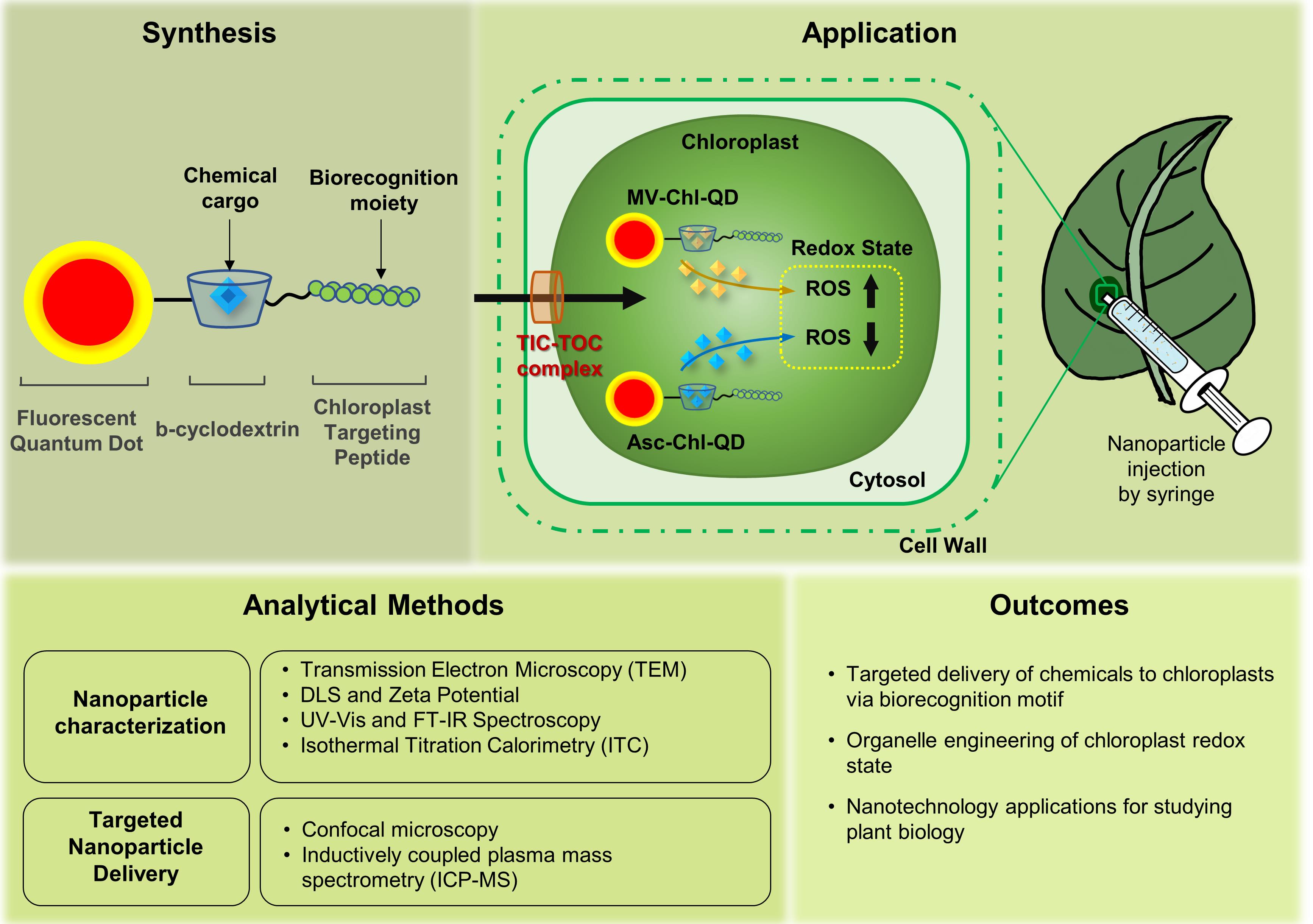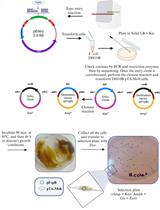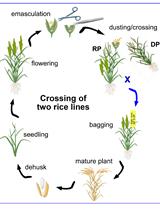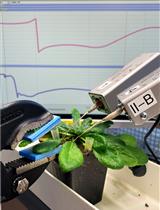- EN - English
- CN - 中文
Peptide-mediated Targeting of Nanoparticles with Chemical Cargoes to Chloroplasts in Arabidopsis Plants
多肽介导的化学物质纳米粒对拟南芥叶绿体的靶向作用
发布: 2021年06月20日第11卷第12期 DOI: 10.21769/BioProtoc.4060 浏览次数: 4319
评审: Zinan ZhouLusheng FanDemosthenis Chronis
Abstract
Plant nanobiotechnology is a flourishing field that uses nanomaterials to study and engineer plant function. Applications of nanotechnology in plants have great potential as tools for improving crop yield, tolerance to disease and environmental stress, agrochemical delivery of pesticides and fertilizers, and genetic modification and transformation of crop plants. Previous studies have used nanomaterials functionalized with chemicals, including biocompatible polymers with charged, neutral, or hydrophobic functional groups, to improve nanomaterial uptake and localization in plant cells. Recently, the use of biorecognition motifs such as peptides has been demonstrated to enable the targeted delivery of nanoparticles in plants (Santana et al., 2020). Herein, we describe a bio-protocol to target nanoparticles with chemical cargoes to chloroplasts in plant leaves and assess targeting efficiency using advanced analytical tools, including confocal microscopy and elemental analysis. We also describe the use of isothermal titration calorimetry to determine the affinity of nanomaterials for their chemical cargoes. Nanotechnology-based methods for targeted delivery guided by conserved plant molecular recognition mechanisms will provide more robust plant bioengineering tools across diverse plant species.
Graphic abstract:

Targeted delivery of nanomaterials with chemical cargoes to chloroplasts enabled by plant biorecognition
Background
Nanomaterials have enabled improved diagnostic tools, drug delivery, bioengineering, and tissue regeneration platforms for mammalian systems (Das et al., 2014; Li et al., 2016; Patra et al., 2018). Applications of nanotechnology in plant bioengineering and nano-enabled agriculture have recently emerged (Kah et al., 2019; Lowry et al., 2019). The use of plant nanobiotechnology has great potential in developing valuable diagnostic and therapeutic tools for improving crop management, resistance to diseases and environmental stresses, targeting the delivery of agrochemicals, and genetic bioengineering tools (Wang et al., 2016; Yin et al., 2018; Giraldo et al., 2019; Wang et al., 2019; Santana et al., 2020).
Currently, the delivery of chemicals in plants leads to unintended alterations in plant function and environmental pollution from chemical leaching (Nagajyoti et al., 2010; Smith and Gilbertson, 2018; Lowry et al., 2019). Nanotechnology approaches have relied on size, surface charge, and hydrophobicity modifications to tune their distribution in plant cells (Asati et al., 2010; Wong et al., 2016; Wu et al., 2017; Demirer et al., 2019; Hu et al., 2020); however, these approaches based on chemical coatings cannot target specific plant subcellular compartments with high precision. Nanoparticle functionalization with targeting peptide recognition motifs enables plant molecular machinery to guide the nanomaterials to plant organelles in vivo with high specificity (Santana et al., 2020).
Herein, we present a protocol for synthesizing, characterizing, and detecting a nanomaterial platform that targets the delivery of chemicals to chloroplasts in wild-type Arabidopsis thaliana (Col-0) using a peptide recognition motif that is relatively conserved in dicotyledonous plants. We describe techniques for the synthesis and characterization of targeted quantum dots using UV-vis spectroscopy, Fourier-transform infrared spectroscopy (FTIR), dynamic light scattering (DLS), and transmission electron microscopy (TEM). We outline methods to image and quantitate the nanoparticles in plant chloroplasts using advanced analytical tools with high resolution, including confocal microscopy and inductively coupled plasma mass spectrometry (ICP-MS). These nanomaterials target the delivery of chemicals to the chloroplast, allowing tuning of their function, e.g., redox state, with higher specificity and efficiency than chemicals alone.
The use of quantum dots coated with biorecognition moieties to target the delivery of chemicals to chloroplasts can be extended to sustainable nanomaterials for the targeted delivery of genetic elements, nanosensors, nutrients, or pesticides across multiple plant species.
Materials and Reagents
Centrifugal filter (Merck Millipore, Amicon Ultra 15, molecular weight cut-off, 10,000 Da)
Arabidopsis thaliana seeds (ecotype Columbia seed stock source CS60000)
NaBH4, purum p.a., ≥96% (gas-volumetric) (Sigma-Aldrich, catalog number: 71320-25G, CAS Number 16940-66-2)
Succinimidyl-[(N-maleimidopropionamido)-tetraethyleneglycol] ester (NHS-PEG4-MAL linker, Thermo Fisher Scientific, U.S.A.)
Perfluorodecalin (Acros Organics, 25 g, 90% mixture of cis and trans, CAS 306-94-5)
Tellurium powder, Te; 99.8%, (Sigma-Aldrich, catalog number: 266418-25G)
Ethanol 200 proof (Fisher Scientific, Acros organics 61509-0040 4L)
Molecular grade H2O (Corning, catalog number: 46-000-CM)
Cadmium chloride hydrate (Sigma-Aldrich catalog number: 529575)
Mercaptopropionic acid (Sigma-Aldrich, catalog number: M5801-100G)
Sodium hydroxide solution (50% w/w certified; Fisher Scientific, catalog number: SS254-1, 1L, CAS number 1310-73-2)
1 ml NORM-JECT® (4010-2000V0)
1-Ethyl-3-[3-dimethylaminopropyl] carboamide hydrochloride, EDC, 5 g (G-Biosciences, catalog number: BC 25-5)
N-Hydroxysuccinimide, NHS, 25 g (Thermo Scientific, catalog number: 24500)
TES buffer (Sigma Life Science, catalog number: T1375-25G)
3-Aminophenylboronic acid hydrochloride (Sigma-Aldrich, catalog number: 410705-1G)
L-Ascorbic acid (Fisher Chemical, catalog number: A61-100)
Methyl viologen (Acros organics, catalog number: A227320010)
Centrifugal filter (Merck Millipore, Amicon Ultra 15, molecular weight cut-off, 10,000 Da, catalog number: UFC901024)
NaOH 1% solution
HCl 1% solution
Mono-(6-ethanediamine-6-deoxy)-beta-cyclodextrin (PONOCO enterprise, CAVCON, catalog number: 60984-63-6) (store at -4°C)
NHS-PEG4-Maleimide, SM-PEG pegylated crosslinker (NHS-PEG4-MAL) (Thermo Scientific, catalog number: 22107) (store at -20°C)
RbcS targeting peptide was designed from Rubisco small subunit transit peptide sequence (GenBank: OAP15425): MASSMLSSATMVGGC (1432.72 g/mol) (Genscript) (store at -20°C)
Carolina microscope observation gel (Corning, 2984-75x25)
Cheesecloth grade 50 (VWR International, catalog number: 470150-438 (PK))
1× chilled sucrose buffer (pH 7.3) (see Recipes)
Equipment
Erlenmeyer flasks (200 ml)
Fume hood
-20°C freezer
Plastic plant growth inserts (T.O. plastics st-10804)
Hot plate/stir plate (IKA RCT basic safety control magnetic stirrer, RCT BS001)
Bath sonicator (Elmasonic p, P-30H, #101-3737)
UV-vis spectrophotometer (Shimadzu 2600, UV-2600 EN)
Malvern 1600 zetasizer (Nano S, ZEN1600)
Folded capillary zeta cell cuvette (Malvern Panalytics, DTS1070)
Disposable cuvettes (Spectrum Laboratory Products, 330-10304P5)
Quartz open top cuvette 10 mm (Starna Cells Inc, 18-Q-10)
FTIR spectrometer (Bruker Alpha I)
TEM (Philips FEI Technai 12 microscope)
Leica SP5 Confocal Microscope
Malvern isothermal titration calorimeter (G.E. Healthcare, MicroCal ITC200 instrument)
ICP-MS (Agilent 7700x)
Grinder or macerator (Intertek KWG-100A)
Software
ImageJ
Procedure
文章信息
版权信息
© 2021 The Authors; exclusive licensee Bio-protocol LLC.
如何引用
Santana, I., Hu, P., Jeon, S., Castillo, C., Tu, H. and Giraldo, J. P. (2021). Peptide-mediated Targeting of Nanoparticles with Chemical Cargoes to Chloroplasts in Arabidopsis Plants. Bio-protocol 11(12): e4060. DOI: 10.21769/BioProtoc.4060.
分类
植物科学 > 植物细胞生物学 > 细胞间通讯
分子生物学 > 纳米颗粒
您对这篇实验方法有问题吗?
在此处发布您的问题,我们将邀请本文作者来回答。同时,我们会将您的问题发布到Bio-protocol Exchange,以便寻求社区成员的帮助。
提问指南
+ 问题描述
写下详细的问题描述,包括所有有助于他人回答您问题的信息(例如实验过程、条件和相关图像等)。
Share
Bluesky
X
Copy link












